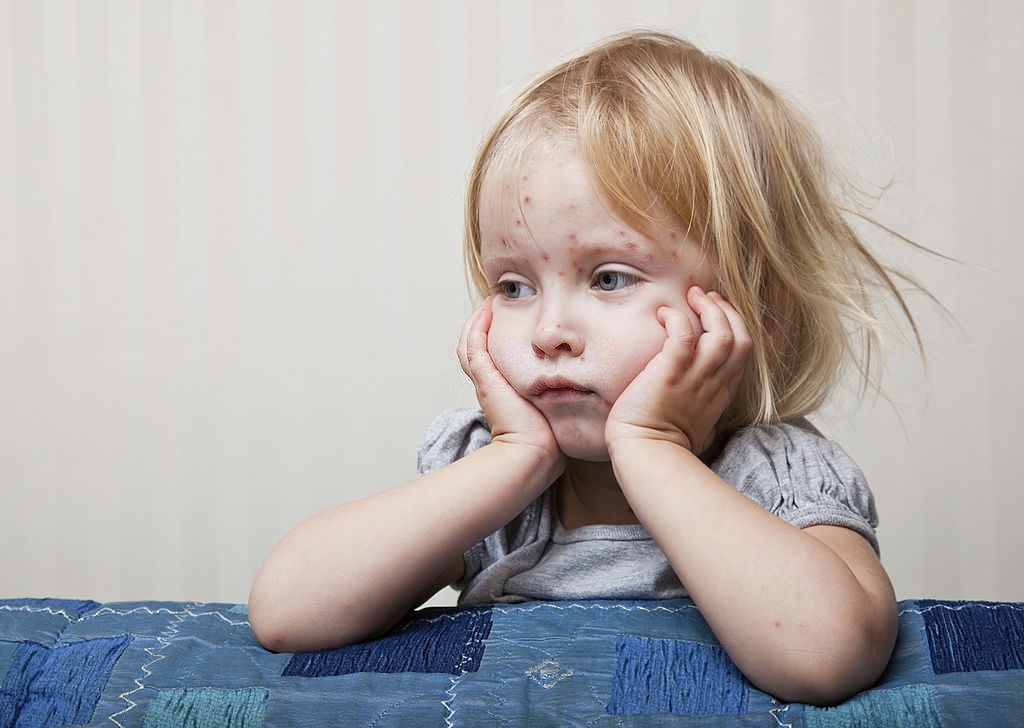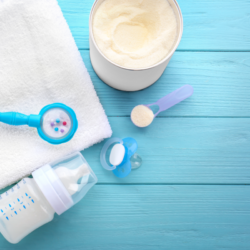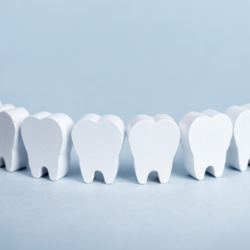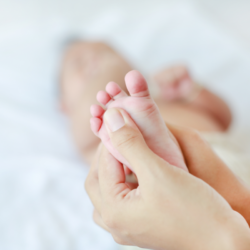In the majority of cases, childhood eruptive fevers are caused by exanthematic viruses or even bacterial aetiologies. Much less frequently, these eruptive fevers are the first manifestations of a potentially more severe condition.
Viral eruptive diseases in children
Eruptive diseases are mainly seen in children, as they often mark the first infection with various infectious agents. They then confer immunity, which can be permanent if regular contact with the infectious agent is maintained. Although generally benign, these diseases are often contagious or even epidemic, posing a threat to vulnerable individuals such as immunocompromised people or pregnant women. It is also crucial to recognise rare eruptive diseases, which may indicate a serious condition.
Measles
Measles is a highly contagious disease caused by a virus belonging to the Paramyxoviridae family. Infected humans are its only reservoir, even if there are no apparent symptoms. The silent incubation period lasts just over 12 days on average. A characteristic sign of the disease, known as Köplick’s sign, appears in the form of small whitish to bluish eruptive spots on the inside of the cheek, near the first molar.
It is essential to detect this sign, as it appears a few days before the characteristic measles rash. Measles vaccination has had a significant impact, preventing 56 million deaths between 2000 and 2021, making it a crucial investment in public health.
Measles is highly contagious and can lead to serious complications and even death. Symptoms include fever, cough, runny nose and a rash all over the body. Measles can lead to a number of serious complications. These include blindness,encephalitis, severe diarrhoea, ear infections and respiratory problems. Pregnant women are particularly at risk of complications.
The measles virus is transmitted by contact with infected nasal or throat secretions. It can remain active in the air or on surfaces for several hours. Vaccination is crucial to preventing the disease. Systematically administering the vaccine to children is the most effective method of controlling measles.
However, in 2022, only around 83% of children worldwide received a dose of measles vaccine before their first birthday. This rate has fallen since 2008. Epidemics can break out if vaccination is insufficient.
The phytotherapy treatment proposed is a cypress extract.
Infantile roseola
Roseola is a generally benign viral infection that suddenly manifests itself with a high fever (39-40°C) lasting around 3 days. This fever is resistant to antipyretics, which increases the risk of convulsions. After the fever, a non-itchy rash appears, which disappears within two days. To treat roseola, it is essential to maintain good hydration, reduce the fever and prevent convulsions.
Roseola is a benign viral disease that mainly affects young children and is caused by the human herpes virus type 6. It is characterised by a sudden high fever, followed by a skin rash.
The virus is transmitted by contact with secretions from the nose and throat, in particular through the saliva of an infected child, droplets of saliva dispersed by coughing or sneezing, or hands contaminated by the nose or mouth of a sick child.
Symptoms of roseola include high fever, sometimes associated with digestive problems, irritability, swollen glands and a characteristic rash of pinkish spots, mainly on the chest, abdomen and face.
Roseola is generally benign, and most children recover within a few days. Treatment is aimed at relieving the symptoms of fever, and paracetamol is preferred. It is essential to consult a doctor in the event of a high fever in an infant under 3 months of age, or in the presence of worrying symptoms. Roseola is viral, so antibiotics are not necessary. Roseola prevention involves hygiene measures such as washing hands, avoiding sharing personal objects, and limiting contact in the event of infection.
The suggested phytotherapy treatment is elderberry extract.
Chickenpox
Chickenpox is an extremely contagious viral infectious disease that most often affects babies and young children. It causes a rash of blisters on the skin and mucous membranes. It heals in around ten days, but reactivations in the form of shingles are possible in adulthood.
The chickenpox virus is transmitted in two main ways. Firstly, by direct contact with the blisters on the skin and mucous membranes. Secondly, by inhaling droplets of saliva from an infected person. A person can transmit the virus even before the rash appears, and remains contagious until the vesicles dry, forming scabs.
In children, chickenpox manifests itself as a moderate fever, raised rash, blisters and itching. To prevent the transmission of chickenpox, strict hygiene measures are necessary. It’s important to keep your child at home until the scabs have formed. You should also air the room regularly, avoid public places and teach your child good hygiene practices.
It is essential to consult a doctor if complications arise or if a person at risk contracts chickenpox. The aim of treatment is to reduce the symptoms. As chickenpox is viral, antibiotics are not useful. In some cases, post-exposure vaccination is recommended. After exposure to the virus, varicella-zoster immunoglobulin may be necessary in specific situations.
The suggested phytotherapy treatment is a mixture of cypress extract (for its antiviral activity, as mentioned above) and liquorice. For adults, an extract of burdock (a major plant in skin diseases, whether dry or oozing, superinfected or likely to be superinfected) is added to the mixture.
Molluscum contagiosum
Molluscum contagiosum is a common rash in children caused by a virus called Poxvirus. This virus proliferates in damp environments such as swimming pools, showers and beaches. Symptoms of Molluscum contagiosum appear as small pink or white domed papules, usually less than 0.5 centimetres in diameter, with a small central depression. Molluscum contagiosum is contagious and is spread by direct contact with the skin or contaminated objects.
Papules may appear on different parts of the body, but they are generally painless and non-itchy. Diagnosis is based primarily on the appearance of the rash on clinical examination. Although most papules disappear spontaneously within one to two years, some may persist for longer and require treatment.
Treatment of Molluscum contagiosum may involve the application of specific creams, cryotherapy, burning or removal of the papules. In children, papules usually appear on the face, trunk, arms and legs, while in adults they are more common in the genital area.
There are different types of Molluscum contagiosum, with type 1 being the most common. Preventive measures include avoiding direct contact with infected people, maintaining strict hand hygiene and not scratching or touching lesions to prevent spread. Although Molluscum contagiosum is generally benign, it can cause itching and discomfort, but treatments are available to speed up its disappearance. It is also advisable to boost the immune system with food supplements and vitamins to prevent infection.
The phytotherapy treatment proposed is an extract of cypress (for its antiviral activities, mentioned above), taken orally and applied topically.
Hand-foot-and-mouth syndrome
Hand-foot-and-mouth syndrome, common in nurseries and schools, is a benign but highly contagious viral infection. Mainly caused by the coxsackie enterovirus, it mainly affects young children, but can also affect adults. Symptoms last around 10 days, with skin eruptions (papulovesicles) in the mouth and on the extremities of the limbs. The virus is excreted in the faeces for several weeks after the illness.
This infection mainly occurs in spring, summer or early autumn. Although mostly benign, severe forms can occur, especially in the Asia-Pacific region, where enterovirus 71 can cause severe complications. Infected people are contagious a few days before and during the illness. Transmission occurs through direct or indirect contact, via nasal secretions, saliva, skin lesions or contaminated objects. It is possible to be infected several times by different viruses.
Initial symptoms include fever, loss of appetite, headache, sore throat, abdominal pain and diarrhoea, followed by rashes in the mouth and on the hands and feet. In the event of numerous lesions, it is advisable to keep the child at home and consult a doctor. Care includes hygiene, appropriate nutrition and hydration. Antibiotics are not effective against this virus.
To prevent transmission, maintain good hygiene, wash hands frequently, avoid sharing personal objects and keep environments clean. Pregnant women should be particularly careful. In the event of persistent or severe symptoms, medical advice should be sought.
In the absence of specific allopathic treatment, the phytotherapy treatment proposed is an ethanolic extract of climbing ivy.
Winter gastroenteritis
Gastroenteritis, a common digestive infection in children, is often viral in origin (such as rotavirus). Symptoms include vomiting, diarrhoea, abdominal pain and fever, which can lead to dehydration.
This infection affects the mucous membranes of the stomach and intestines. It is mainly caused by viruses, such as rotavirus. This virus is highly contagious and often causes epidemics among children, particularly in winter. The viruses remain active on the hands for up to four hours. They can also survive for several days or weeks on objects or surfaces. Gastroenteritis is transmitted in several ways. It can be spread by direct contact with a sick person. Ingestion of contaminated food or water is another route of transmission. Contact with objects infected with the virus or bacteria is also a means of contagion. A cured child may remain contagious for several days after the symptoms have disappeared.
Symptoms are viral in origin, and antibiotics are not recommended as a first-line treatment. In addition to rigorous dietary and hygiene measures (particularly hydration) and the administration of the probiotic strain Lactobacillus rhamnosus GG (also recommended for this indication by paediatric learned societies), the treatment involves a mixture of extracts ofechinacea (for children aged 12 and over only) and liquorice (properties in functional intestinal disorders with diarrhoea).
In the event of severe diarrhoea, replace the liquorice with walnut and, in the event of severe nausea, add lemon balm to the preparation (children over 12 only). Clinical monitoring must remain attentive, due to the risk of rotavirus diarrhoea, which requires emergency hospitalisation due to its seriousness, which can rapidly threaten the child’s vital prognosis.
Thrush in infants
Oral fungal infections, commonly known as thrush, often affect the tongue and inside of the cheeks, especially in infants. These fungal infections manifest themselves as white, caseous patches resembling curdled milk, which can cause pain when feeding or bottle-feeding. Although they are not serious, rigorous hygiene and local care are necessary to treat them.
Thrush is characterised by whitish deposits on the baby’s tongue, gums and cheeks. These deposits do not disappear with rubbing and can make the mouth dry, with cracks at the corners of the mouth, which are often red and swollen. Diaper rash is also often associated (same aetiology). If left untreated, fungal infections can spread to the digestive tract, causing vomiting, diarrhoea and diaper rash.
The cause is a microscopic fungus, Candida Albicans, which occurs naturally in the mouth. Treatment includes a local antifungal agent, to be applied rigorously for a fortnight. After each meal, gently clean the baby’s mouth with a sterile compress soaked in alkaline water, then apply the antifungal gel.
Breast-feeding mothers can also be affected by mammary candidiasis, characterised by irritated, cracked or itchy nipples. It is important to apply the antimycotic gel after each feed and to maintain strict hygiene, including showers with alkaline soap and frequent changes of breast pads.
A liquorice extract (for its antiviral and antifungal properties) should also be used quickly, not forgetting nipple care when breastfeeding. Round off by cleaning the mouth, breasts and/or teats (after sterilisation) using sodium bicarbonate or bicarbonated mineral water such as Vichy Célestin as a mouthwash (after opening the mouth).
Plants to use against eruptive diseases
Viral rashes in children, such as chickenpox, measles and roseola, are a major concern in paediatrics. They are common, highly contagious and can lead to complications. These diseases are characterised by skin lesions, including rashes, pustules and papules. Historically, they have been treated using conventional methods. This includes the use of antivirals and symptomatic treatments. Recently, there has been a growing interest in alternative and complementary approaches. This has led to further exploration of the therapeutic properties of plants for these diseases.
The antiviral activities of Cypress
Cypress proanthocyanidolic oligomers or OPCs are flavonoid polymers with a dual mode of antiviral action. On the one hand, they have protein-binding properties, particularly on enzyme substrates and cell surface proteins. In effect, OPCs prevent viruses from adhering to their host cells, thereby limiting virus/host cell recognition and viral replication. In addition, they induce virus lysis, leading to a rapid reduction in viral load.
Cypress, a plant with multiple pharmacological properties, stands out in particular for its antiviral effects and its protection of connective tissue. Proanthocyanidolic oligomers (OPCs), flavonoid polymers present in cypress, play a key role in these properties. On the one hand, OPCs prevent viruses from adhering to host cells, thereby limiting their replication. Secondly, they induce viral lysis, rapidly reducing the viral load. In vivo studies have demonstrated the effectiveness of cypress OPCs in reducing herpes lesions.
Cypress also acts as a protector of connective tissue, effective against elastase and collagenase, two enzymes that degrade this tissue. It protects against oxidative damage and preserves collagen. Hydroalcoholic extraction of the components of the female cypress cones guarantees optimum conservation of these properties.
Cypress also has significant circulatory and angioprotective properties. Rich in tannins, it has a venotonic and vasoconstrictive action, proving effective in the treatment of symptoms of venous insufficiency and haemorrhoidal disorders. A study revealed that Cypress powder outperformed diosmin, a leading veinotonic, in terms of efficacy.
Antiviral and antipyretic activity of Elderberry
Asantiviral and antibacterial agents, they inhibit haemagglutinins, viral glycoproteins, thus blocking viral entry into host cells. They also boost the immune system, increasing the production of cytokines. Research has confirmed their action against several types of bacteria, both Gram-positive and Gram-negative.
In terms of anti-inflammatory and immunostimulant action, elderberries are effective at respiratory level, promoting the production of inflammatory cytokines and increasing bronchial secretions. In colitis patients, their extract improves the health of the colonic mucosa, reducing macroscopic damage.
From a metabolic and vascular point of view, these anthocyanins increase the protection of endothelial cells against oxidative stress, thus preventing the cellular dysfunction associated with cardiovascular disease. The anti-diabetic properties of elderberry extract have also been highlighted, offering protection against the glycation of haemoglobin.
Licorice’s anti-inflammatory, antiviral and antibacterial properties
Enoxolone or β-glycyrrhetinic acid, used in the symptomatic treatment of moderate inflammatory disorders such as pruritus, has a cortison-like effect. In the laboratory, liquorice glycyrrhizin inhibits the proliferation of various DNA viruses, in particular Herpesviridae, and liquorice isoflavonoids, such as glabridin, have antibacterial activity.
Licorice root has remarkable anti-inflammatory properties. Glycyrrhizin mimics the effects of mineralocorticoid and glucocorticoid hormones. It reduces the activity of the enzyme 11-β-hydroxysteroid dehydrogenase. This leads to an increase in cortisol and other steroid hormones in the blood. Liquorice extract also blocks the production of ecosanoids, such as prostaglandin E2. This action is achieved by inhibiting cyclooxygenases and lipoxygenases. In addition, the extract reduces inflammation in macrophages caused by lipopolysaccharide.
Liquorice also has digestive properties, particularly anti-ulcer. It acts locally on mouth ulcers, reducing pain and ulcer lesions. Against Helicobacter pylori, glycyrrhetic acid and liquorice polysaccharides have shown significant inhibitory activity.
Its hepatoprotective properties are also noteworthy. An aqueous extract of liquorice increases the activity of phase I enzymes, and glycyrrhizin inhibits the multiplication of hepatitis A and C viruses. The immunomodulating effects of liquorice include immunosuppressive properties, such as inhibiting the cutaneous anaphylactic reaction and reducing the cytolytic activity of complement. It also reduces the destruction of cartilage in rheumatoid arthritis.
As ananti-infective agent, liquorice has significant antiviral and antibacterial effects. It inhibits the proliferation of many viruses and bacteria, including herpes and hepatitis viruses, as well as Streptococcus pyogenes and Haemophilus influenzae. Finally, its antioxidant and cytoprotective properties include anti-angiogenic and anti-tumour activity, regulating the production of growth factors and inducing apoptosis in cancer cells.
Ivy’s antiviral properties
The anti-infectious action of Echinacea
Echinacea has shown anti-adhesive activity against the pathogen Campylobacter jejuni, which causes diarrhoea. Varieties ofEchinacea, such as Echinacea purpurea, Echinacea angustifolia and Echinacea pallida, are reputed to boost the immune system and fight infections. These plants offer anti-inflammatory benefits, helping to relieve joint problems. They also speed up wound healing and protect cells thanks to their antioxidant properties. They are traditionally used to treat infections caused by Candida albicans. However, before using echinacea, you should seek the advice of a health professional. This is particularly important if you are allergic to plants in the Asteraceae family, are taking medication or have pre-existing health conditions.
In terms of immunostimulant properties, echinacea boosts the immune system’s defences against infection, thanks to its alkylamides and polysaccharides. Studies show that echinacea benefits stress-induced immunosuppression by increasing splenocyte proliferation, enhancing natural killer (NK) cell activity and modifying T lymphocyte subsets and cytokine levels.
In terms of its anti-infectious properties, echinacea has long been used for its wound-healing and anti-infectious properties. It offers antibacterial and antiviral benefits, useful in the prevention and treatment of various skin conditions and infections such as colds, bronchitis, tonsillitis, sinusitis, gastrointestinal and urogenital infections.
Echinacea has an antibacterial action that inhibits the growth of certain germs and has overall virucidal activity, particularly against coronaviruses, with proven antifungal activity against Candida albicans. Echinacea also has dose-dependent anti-inflammatory properties, acting locally and generally via its polysaccharides and alkylamides. It inhibits various enzymes and promotes anti-inflammatory activation of macrophages, with a positive impact on ENT and respiratory infections and other inflammatory conditions.
Can the risk of recurrent eruptive infections in children be prevented?
Start this preventive treatment if you have more than 3 infections a year, or even fewer if you are tired or exposed to risks (such as in a crèche or community centre). Use plant preparations in maintenance doses, diluted in plenty of water, a thick juice such as pear or apricot juice, or a syrup. Take them 5 days a week. Start treatment 1 month before the virus season and continue until the end of the cold season or risk period.
- In the event of a low to moderate risk of recurrence, without an allergic background (no asthma, allergic rhinitis, eczema or urticaria): Echinacea extract (children over 12 only).
- If the risk of recurrence is moderate to high, in a weakened immune system, with fatigue: cypress/echinacea extract (children over 12 years of age) / elderberry.
- For moderate to high risk of recurrence, particularly in the presence of a personal or family history of allergies (atopy): elderberry extract. This formula is replaced by the elderberry/plantain extract blend for asthma prevention.
Medical literature and clinical trials
- Clement C., Mise en évidence et recherche du mode d’action antivirale d’un proanthocyanidol, Mémoire CNAM, CRA, 1993
- Harnett J, Oakes K, Carè J, Leach M, Brown D, Cramer H, Pinder TA, Steel A, Anheyer D. The effects of Sambucus nigra berry on acute respiratory viral infections: A rapid review of clinical studies. Adv Integr Med. 2020
- Hawkins, J., Baker, C., Cherry, L., & Dunne, E. (2019). Black elderberry (Sambucus nigra) supplementation effectively treats upper respiratory symptoms: A meta-analysis of randomized, controlled clinical trials
- Lee YM, Hirota S, Jippo-Kanemoto T, Kim HR, Shin TY, Yeom Y, Lee KK, Kitamura Y, Nomura S, Kim HM. Inhibition of histamine synthesis by glycyrrhetinic acid in mast cells cocultured with Swiss 3T3 fibroblasts. Int Arch Allergy Immunol. 1996
- Mitsher L.A. et al, Antimicrobial agents from higher plants. Antimicrobial isoflavonoids and related substances from Glycyrrhiza glabra L. var typica, J Nat Prod, 1980
- Song J.H. et al. Antiviral Activity of Hederasaponin B from Hedera helix against Enterovirus 71 Subgenotypes C3 and C4a Biomol Ther (Seoul), 2014
- Bensch K. et al, Investigations into the antiadhesive activity of herbal extracts against Campylobacter jejuni, Phytother Res. 2011







